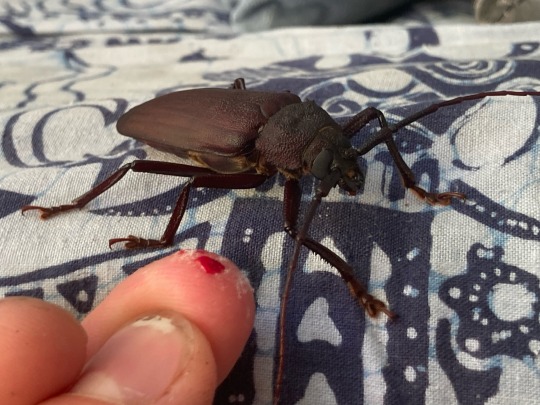#agrianome
Explore tagged Tumblr posts
Text
poinciana longicorn!!!!!!


absolutely gorgeous huge guy who gave me a mighty and respectable bite! (below the cut due to. blood [not much]). the bite was entirely provoked and my fault due to me picking it up to relocate it with full knowledge they can give a powerful bite
what a guy!!!!!!!!

#beetle#longicorn beetle#coleoptera#cerambycidae#agrianome#agrianome spinicollis#poinciana longicorn#i absolutely love these guys#very beautiful. very powerful!!!!
80 notes
·
View notes
Text
Week 9: Starting the final project
In this stage of the unit, we start working on our iterative development of our proposed artwork for Barrambin Park. As the specific location has been found during the last week, we now explore the different shapes and techniques we can use for our artwork and its modules.
The Shape
First, we started brainstorming on the shape of the module. This led us to create a braindrawing of the first shapes that came to mind. Options found were among others organic shapes, basket-like shapes, geometric shapes, plant-related shapes, water shapes or animal shapes. We imagined the possibility of sounds coming out of the different modules, or them being powered by sun energy.

To create a greater level of depth in our modules, we thought of the possibility to relate them to the plant species growing nearby our proposed artwork. These were found in the Ecological Assessment Report for the applicant Brisbane City Council. The trees we will use to hang our modules on is most likely the Sydney blue gum (Eucalyptus saligna) (SOURCE). This tree is one of the significant species within Barrambin Park. As Eucalyptus grandis is often confused and very similar to Eucalyptus saligna, there could be a possibility of incorrect species designation (Skolmen, 1998). Eucalyptus saligna bears flowers that are arranged in groups of seven, nine or eleven. These flowers sit on an unbranched peduncle. Regarding the fauna, the grey-headed flying fox eats this trees' flowers, crimson rosella its seeds and multiple insect species such Paroplites australis and Agrianome spinicollis have been seen as residents of this tree (Euclid, n.d.; PlantNET, n.d.; Benson & McDougall, 1993). Observing the plant's features, we saw multiple interesting structures that could possibly be used in our project. These include its buds, leaves and seeds.





These images, deducted from Euclid (n.d.), show the main characteristics of Eucalyptus saligna. These formations will help us in our search for a final shape of the modules. For at least one of the modules, we wanted to recreate the structure of the seed pods. By creating a digital version of this seedpod and placing it in the before taken image of the site, the appearance of our final artwork can be simulated.


The above shown images, made using the software Maya, represent one of our possible modules.
References:
Meskimen, G., & Francis, J. K. (1990). Eucalyptus grandis Hill ex Maiden. Silvics of North America: Hardwoods, 19(654), 305.
Skolmen, R. G. (1998). EUCALYPTUS SALIGNA JE Smith. Arboles Utiles de la Región Tropical de América Del Norte, (3), 189.
Ecological Assessment Report (.........)
Euclid (n.d.). Eucalyptus saligna - Fact Sheet Fusion V2. https://apps.lucidcentral.org/euclid/text/entities/eucalyptus_saligna.htm
PlantNET (n.d.). Eucalyptus saligna Sm. https://plantnet.rbgsyd.nsw.gov.au/cgi-bin/NSWfl.pl?page=nswfl&lvl=sp&name=Eucalyptus~saligna
Benson, D., & McDougall, L. (1993). Ecology of Sydney plant species. Sydney: National Herbarium of New South Wales, Royal Botanic Gardens Sydney.
0 notes
Text
Agrianome
parents: Persée ou Perséphone
époux: Odœdocos
enfant: Oïlée
0 notes